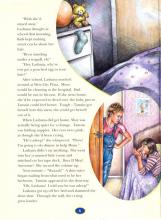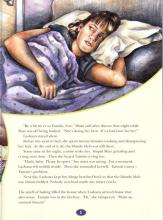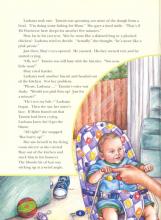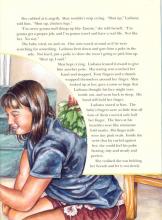Get out of my hair!
- Click on the link to Get out of my hair above
- Click and drag to highlight all 8 images (pages)
- Print (Ctrl-P) and choose landscape
- Tick selection and print.
- The task can be done individually or in groups.
- Before beginning task a), make sure students understand what feeling "resentful" means: feeling annoyed because you believe you are being treated unfairly. You may wish to tell them what it means and/ or ask them to read the second paragraph to help them infer its meaning.
- Before beginning task b), make sure students understand what being "justified" means in this context: to have a good reason for the way you feel, think, or behave.
- For tasks b) and c), tell students that to explain their response of Yes/ No/ Yes and No, they must support their thinking by using evidence from the text and from their prior knowledge, i.e., things that have happened to them, things they have seen, heard, or read about.
- You may need to explain that "a believable character" (task c) is a character who seems real, someone you could believe is living out there in the world - a credible character.
- Responses can be discussed by teacher and student only, or within larger groups. Group discussion has the advantage of giving students opportunities to consider others' ideas and to practise justifying their own.
- reflect critically about character
- evaluate and integrate ideas and information
Possible responses
For task a) we have listed evidence that shows us Lashana's resentment. We have not listed evidence that tells us of her resentment since that type of evidence is relatively easy to identify. (NOTE: not all texts have evidence that "tells" about a character.) The evidence relates to what she looks like (appearance), what she says (dialogue), what she does (action), and what she thinks (thought).
a) How do you know Lashana feels resentful towards Tamsin and the baby?
Appearance (how Lashana looks)Note that in Get Out Of My Hair! evidence for Lashana's appearance as related to this question comes from the visual, not written, text.Page 3:
- The way Lashana is drawn: Her tight-lipped mouth; her frown; her folded arms, all make Lashana look resentful, i.e., annoyed about (what she believes to be) her unfair treatment.
- Lashana mutters "No, thanks" when Mum invites her to come and look at Shay. Thought (what Lashana thinks)
Direct thought: (thought offered directly, as if we are over-hearing the character's mind)Page 4:
- "Wish she'd stayed away," Lashana thought.
Page 6:
- Lashana says to Tamsin "He's not my bab".
- "All right!" Lashana snaps at Tamsin, "But hurry up!"Page 7:
- "Shut up ...Shut up, chicken legs".
- "Shut up, I said."
Action (what Lashana does)
Page 2:
- Lashana yanks the bathroom door open when Tamsin bangs on it.
Page 3:
- Lashana ignores Tamsin's thanks and apologies
- Lashana avoids going home from school because she thinks 'she'd be expected to drool over the baby, just so Tamsin could feel better'.
- Lashana does not say anything to Tamsin even though she can see Tamsin has probably been crying.
- Lashana does not offer to help Tamsin with dinner.
- Lashana turns the music up even though she knows Shay is asleep.
- Lashana slams the door on Tamsin.
- Lashana's gesture to Tamsin (visual text) implies a 'So what?' response to Tamsin's "Oh, Lashana! I told you he was asleep!"
- Lashana stays silent when her mother asks her to be kinder to Tamsin.
- Lashana takes a biscuit but doesn't thank Tamsin.
- Lashana takes another biscuit and heads out of the kitchen in response to Shay's crying even though she knows Tamsin is busy.
- Lashana sticks Shay in his bouncer instead of comforting him.
- Lashana bends down and gives Shay a poke in the side./ Lashana leans forward and gives him another poke.
Page 6:
- "Actually," she [Lashana] thought, "he's [Shay's] more like a pink prune."
- "I'm never gonna stuff things up like Tamsin." She told herself. "I'm gonna get a proper job, and I'm gonna travel and have a real life. Not like her. No way". (This statement can be interpreted as showing resentment because it comes straight after Lashana has said "Shut up ... Shut up, chicken legs" to Shay.)
Indirect thought (thought that is reported by the storyteller/ narrator or author). Note that in the evidence that follows, it is the author who reports Lashana's thoughts.
Page 2:
- It was Tamsin's fault for interrupting her - Tamsin and stupid Shay.
- Lashana's sister and her baby had only been in the house for two weeks - but it felt like two years. The bathroom was full of baby wipes and baby shampoo. The washing machine was so full of nappies that Lashana couldn't fit in her basketball gear. She didn't even have her own room anymore. Tamsin and stupid Shay had it, and she'd been pushed into the tiny spare room.
- Just because she was a girl, everyone expected her to coo over babies. Well, she wasn't going to. And Shay didn't look like an Olympic swimmer, either. He looked like a skinned frog. Or a chicken with no feathers. Anyway, the only time she'd picked him up - because Mum had told here to - Shay's bottom had made a disgusting noise, followed by a disgusting smell. And then the nappy had leaked and left a disgusting stain on Lashana's T-shirt.
- Just as well [that Tamsin didn't comment on Lashana's blonde streak]. (This suggests Lashana would be easily provoked into an argument with Tamsin.)
- If she went home, she'd be expected to drool over the baby, just so Tamsin would feel better. Tough - Tamsin got herself into this mess; she could get herself out of it.
- Shay was actually being quiet for a change.
- A thin voice began wailing from what used to be her bedroom.
Page 5:
- Stupid Shay, grizzling and crying next door.
- Tamsin's mess - Tamsin's problem.
- Was he [Shay] more like a skinned frog or a plucked chicken?
- Not her problem.
This resource was trialled by 40 students. The trial involved Year 7 and 8 students from 4 schools.
Task a): How do you know Lashana feels resentful towards Tamsin and the baby?
Appearance
One trial student noted Lashana's appearance as evidence of her resentment towards Tamsin and her baby.
According to Burroway, "our eyes are our most highly developed means of perception ... it is appearance that prompts our first reaction to people" (pages 81-82). A character's appearance - their clothing, features, shape, style, the way they hold themselves and objects associated with them such as the car they drive or the house they live in, make statements about who the character is, what kind of person they are, their character, the "inner" person.It is not Lashana's appearance in terms of her features or her clothes that give strong evidence for her being resentful. It is her demeanour; her general bearing, especially on page 3, is defiant (boldly disobedient); her folded arms suggest she is hostile/ antagonistic/ opposed to, or in some kind of conflict with, those around her. Given that only one student noted Lashana's appearance, vital clues about her emotional state in the visual text on pages 3 and 4 were overlooked. This may be because students at this level no longer value or recognise visual cues as valid evidence. It may also be that some students cannot infer from illustrations.
Dialogue
Most trial students noted dialogue as evidence of Lashana's resentment.
By using dialogue, a writer can simultaneously suggest image, personality, and emotion, enriching the readers' understandings while conveying them economically through to the core of the narrative - in this case, Lashana's resentment towards her sister and nephew.
- She called Shay "chicken legs".
- Lashana kept on telling the baby to "shut up".
Dialogue not including obvious name-calling was not noted by as many students. For example:
- When Lashana's mum asked her to come and look at Shay, and Lashana muttered, "No thanks". These students may have noticed the word "muttered" and used it to help them infer resentment and /or used the text immediately after Lashana says "No thanks" to make an inference.
Action
A small group of trial students noted Lashana's actions as evidence of her resentment.
The actions most of these students identified was when Lashana turned the music up when she knew Shay was asleep and when she ignored her sister's thanks and apologies - both probably familiar to students as ways of expressing annoyance.
No students noted Lashana poking Shay. This surprised the researchers who had anticipated strongly felt opinions on this subject.
Thought
Almost all of the trial students noted Lashana's thoughts as evidence of her resentment.
Lashana's thoughts are either directly quoted as if readers are over-hearing her mind, e.g., "Actually...he's more like a pink prune" (readers can recognise a thought that is a direct quote by the speech marks), or indirectly reported by the author, e.g., 'If she went home, she'd be expected to drool over the baby, just so Tamsin could feel better. Tough - Tamsin got herself into this mess; she could get herself out of it' (speech marks are not used). When a character's thoughts are reported by the author they have the "feel" of a direct quote without actually being one (notice the use of 'she' and 'she'd' above - a direct quote would have used "I" and "I'd"). The indirect reporting of Lashana's thoughts has a strong presence throughout this narrative.
Over a half of the trial students identified the following example of indirect thought:
- It was Tamsin's fault for interrupting her - Tamsin and stupid Shay.This is not unexpected as it appears very early in the narrative; its strong wording would also attract reader attention.
Task b): Is Lashana justified in thinking Tamsin's life is "stuffed up"?
NOTE: There is no right or wrong answer for this task. The purpose of this task is for readers to make a judgement of a character and justify their response, drawing on both the text and their prior knowledge. What is important is the quality of the justifications they give for their stance.Ability to use both text details and background knowledge when making a judgement about a character
About half of the trial students were not able to use both.
The judgements made by about half of the trial students were based both on background knowledge and on details from the text. For example:
- Lashana does not have a good reason to think Tamsin's life is stuffed up because Tamsin can still get a job rather than staying at home looking after the baby. She could get a baby sitter. (No, not justified.)
- Having a baby is an awesome thing, like a gift you are blessed with. But it can also stop you from having a job or career that you have studied for. This is what happened to Tamsin. (Yes, justified.)
- Babies can cry and be irritating but they can be nice if they don't cry too much. My baby cousin keeps me awake when I'm at their place. But I still like him. (Yes and no.)
- It's true that when you have a baby, it takes over your life. There are young girls on the benefit who can't even afford to go out. (Yes, justified.)
These findings suggest that many students over-rely on their background knowledge for evidence, and under-use evidence from the text. Students who neglected to use details from the text cannot be said to have the necessary skills to evaluate a character.
- Tamsin dropped out of polytech and lives at home with her baby who has no father, but she does love her baby and she's still young.
This was accepted because it gives a reason why Lashana was justified: Tamsin dropped out of polytech and lives at home with her baby who has no father and reasons why she wasn't: she [Tamsin] does love her baby and she's still young.
Some students failed to give reasons:
- Tamsin only stuffed up her life a bit by having a baby. (No, she wasn't justified.)
- Her life wasn't as bad as it might have been. (No, she wasn't justified.)
Task c): Has the author been successful in making Lashana a believable character?
NOTE: There is no right or wrong answer for this task. This task requires readers to evaluate the author's construction of character and justify their response using both the text and prior knowledge. What is important is the quality of the justifications they give for their stance.
Appearance - No students noted that Lashana did or did not look like a typical teenager.
Tone - A small group of students noted the change in Lashana's tone, from resentful to more positive, as appropriate or inappropriate:
- At first Lashana really resents the baby and then she finds that something turns over inside her and she starts to like the baby. This is what you would expect to happen.
- Quite a lot of people do feel that they are left out when a younger sibling gets all the attention and you don't, but after you give the baby a chance, it normally turns out alright and you both get along, like in this story.
- In real life you wouldn't go from being worst enemies then straight away being good friends.
Action - A small group noted Lashana's actions as appropriate or inappropriate:
- She acts like a sister might do if they had a baby brother who gets all the attention and so they wouldn't want to have anything to do with the baby.
- I have acted like Lashana, jealous and angry, thinking that no-one cares about me, and done some mean things then. So I think she is like a normal person 100%.
- She doesn't do anything to help with the baby which isn't very mature. But then I get told I'm immature so I guess she's believable.
Thought - A small group of students noted Lashana's thoughts as appropriate or inappropriate:
- Everyone has experienced thoughts and 'scenes' of pain and jealousy like Lashana in their life. I believe that someone can get over these thoughts and stop thinking only about themself and start thinking about other people like Lashana did.
- Everyone has thoughts and feelings like Lashana did, and it's OK for her not to like her sister. I don't always like mine.
- It's pretty unbelievable when Shay's ear makes Lashana think of a small seashell. Nobody goes from loathing to adoring that quickly!
Ability to use text details when making a judgement about an author's construction of a character
Only a small group of students were able to use text details. Most made rather general statements. One student noted:
- Some people are like Lashana and do get a bit jealous or angry with people.
This student is certainly able to form an opinion about the credibility of Lashana as a character but has not explicitly based that opinion on detailed evidence. For example, this student could have noted the author's use of details showing Lashana's jealousy of Shay when her mother 'finally noticed Lashana at breakfast' or Lashana's anger when she 'slammed her door shut' on Tamsin.These findings suggest most students over-rely on their background knowledge for evidence, and under-use evidence from the text. Students who neglected to use details from the text cannot be said to have the necessary skills to evaluate an author's construction of a character.
The following section Students who need more work on using text details is presented as an example of how you might foreground the Key Competencies within reading. In particular, it exemplifies how you might foreground "Using language, symbols and tests" and, to a lesser extent, "Thinking" within reading through a focus on the way authors construct characters with carefully chosen details. This approach requires students to not just understand the text but to understand how the text is constructed and why it is constructed that way. This idea is expanded below. In the table below, Using language, symbols and texts has the largest bolded font because it is the most important to this particular example.

Students who need more work on using text details
Writers build characters with details. Good writers are meticulous in their choice of details, including only those that add value and meaning to the description of a character. It is these details, as well as background knowledge, that a reader uses in order to respond to questions such as "How do you know Lashana is feeling resentful towards Tamsin and the baby?", "Is Lashana justified in thinking Tamsin's life is "stuffed up"?" and "Has the author been successful in making Lashana a believable character?"
Details: telling and showing
Writers may choose to use details that tell readers about characters if they want to convey information quickly. While most writers occasionally tell readers about characters, the writer of "Get Out of My Hair!" does not. If he had however, he may have written something like:
For a moment, Lashana felt upset. (Note that the text in fact says on page 5: For a moment, Lashana felt wobbly inside.)
Had the writer told the reader that Lashana "felt upset", he would not have given the reader the opportunity to come to their own conclusions about how she might be feeling; and, increasingly, modern readers expect to have that opportunity.It is more common for writers of fiction to choose to use details that show characters to readers. For example: For a moment, Lashana felt wobbly inside; and:
She [Lashana] realised she was holding her breath and let it out slowly. (p.7)
Here the reader must infer how Lashana might be feeling: perhaps she's scared that Shay will wake up and start crying again; perhaps she's astonished at herself for being so absorbed in Shay, or perhaps she's so moved by Shay's 'tiny, steady and perfect' pulse that she forgets to breathe.
Ask your students to compare how they respond to having the opportunity to come to their own conclusion about how Lashana might be feeling with how they would respond if the author had simply told them "Lashana was amazed at how perfect Shay was".
Details: general and specific
When writers tell readers about characters they use details that are general or broad. For example, imagine again that the writer of Get Out of My Hair! had written:
For a moment, Lashana felt upset (Again note that the text in fact says on page 5: For a moment, Lashana felt wobbly inside.)
The word "upset" is general (or abstract); it has a broad rather than specific meaning because it can be generally applied to all sorts of situations. You might like to ask your students to tell you about the situations "upset" can be applied to in an attempt to show them that it is not specific to any particular situation. (Note that at this point your students will probably be unclear about why "upset" is general; in fact they may even argue that it has a specific meaning. It will probably not be until the end of the following exercise that they have a clearer understanding.)However, when writers show characters to readers they use specific (or concrete) details. For example:
His ear made Lashana think of a small seashell. (p.8)
Here readers create an image that is specific. They create a vivid picture in their heads; they can "see" this image. Most importantly, it is vivid pictures like this one that have impact upon readers.
Finally, ask your students to attempt to imagine "upset" (you may need to explain at some point that it is impossible unless they imagine a specific situation).
Reference: Burroway, J. and Stuckey-French, E. (2007). Writing Fiction: A guide to narrative craft. Seventh Edition. New York, NY: Longman.
- Working from home
- Memory
- Voices in the Park
- To Spray or Not to Spray?
- Close Encounters I
- Close Encounters II
- The Weevil's Last Stand
- Big Shift
- Finding a fine mat
- A gift for Aunty Ngā
- Don't miss the bus!
- Saying goodbye
- Why do I blush?
- Rock doc II
- Giant Weta II
- On the Reclaim
- Kissing Frogs
- 'Apa!
- Wolf
- The Blink-off
- Kebabs
- Breakfast for peacocks
- Motocross
- Daisy Data
- No More Cats
- Katie's Birthday









